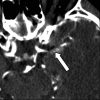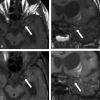The hypodense artery sign
- PMID: 16155153
- PMCID: PMC8148856
The hypodense artery sign
Abstract
An acute intracranial embolus may be associated with a hyperdense artery sign on CT, related to acute thrombus within the affected artery, a phenomenon that is well known and has been extensively documented. We present an unusual case of a middle cerebral artery territory acute infarct with a hypodense artery on CT. The Hounsfield unit attenuation of the embolic lesion was fat density. CT angiography and MR imaging confirmed the fatty lesion to be within the middle cerebral artery.
Figures



References
-
- von Kummer R, Nolte PN, Schnittger H, Thron A, Ringelstein EB. Detectability of cerebral hemisphere ischaemic infarction by CT within 6 hours of stroke. Neuroradiology 1996;38:31–33 - PubMed
-
- Gacs G, Fox AJ, Barnett HJM, Vinuela F. CT visualization of intracranial arterial thromboembolism. Stroke 1983;14:756–762 - PubMed
-
- Pressman BD, Tourje EJ, Thompson JR. An early sign of ischemic infarction: increased density in a cerebral artery. AJNR Am J Neuroradiol 1987;8:645–648 - PubMed
-
- Schuierer G, Huk W. The unilateral hyperdense middle cerebral artery: an early CT sign of embolism or thrombosis. Neuroradiology 1988;30:120–122 - PubMed
-
- Bastianello S, Pierallini A, Colonnese C, et al. Hyperdense middle cerebral artery CT sign: comparison with angiography in the acute phase of ischemic supratentorial infarction. Neuroradiology 1991;33:207–211 - PubMed
Publication types
MeSH terms
LinkOut - more resources
Full Text Sources
Medical
